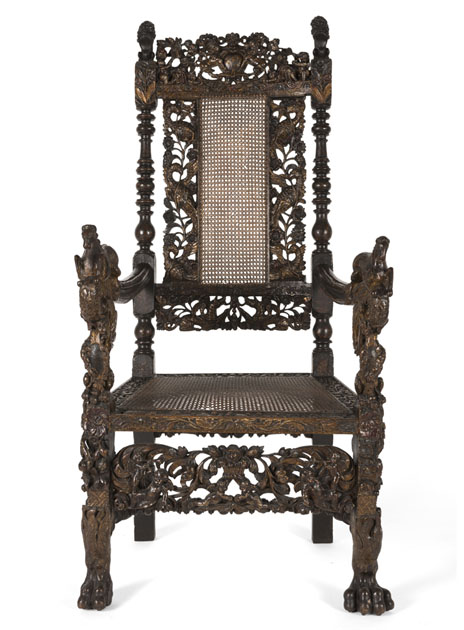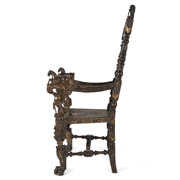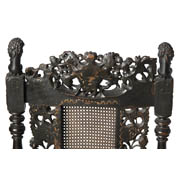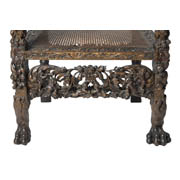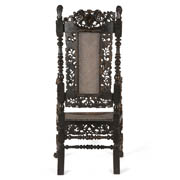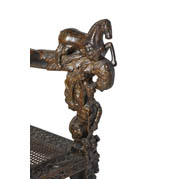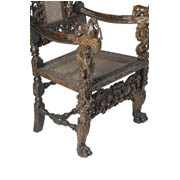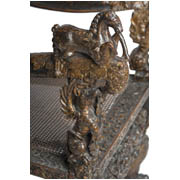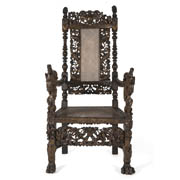Details
- Object type
armchair
- Place Associated
England, London (place of manufacture)
- Date
circa 1690
- Materials
walnut, cane, pigment, gilt
- Dimensions
overall: 1321 mm x 635 mm x 655 mm
- Description
-
This seventeenth-century armchair has a richly carved and turned walnut frame, with caned seat and back. The cresting of the chair back shows a central carved cartouche, painted and gilded with the coat of arms of Charles II and Catherine of Braganza, flanked by heraldic supporters of a crowned lion and unicorn. The cresting also includes carved allegorical figures of Wisdom with book, and Justice with scales, both respectively sitting upon the back of a crouched cherub and facing a kneeling cherub with outstretched arms. The figures are set amongst carved foliage and flowers. The turned back posts are surmounted with lion finials holding shields (probably a later addition to the seventeenth-century chair), on top of a block carved with leaves and flowers on two sides, with trace evidence of red paint and gilding.
The seat back rails, surrounding the caned back, is carved with foliage, and flowers. The side back rails are carved with three sets of birds, perched on a winding vine with flowers and foliage. The bottom seat back rail features two dragons. The seat support is caned surrounded by carved seat rails with foliage and flowers. The arms are carved with horses, placed above curved eagle heads, supported by heraldic dragons holding shields with arms of France and the harp of Ireland. The front legs are carved with entwined foliage and flowers, including roses, and end in lion paw feet. The legs are joined by turned side, middle, and raised back stretchers. The front stretcher is elaborately carved with a central pair of cherubs supporting a basket of flowers, flanked either side by groups of two cherubs playing music on long trumpets, and surrounded by swirling foliage. There are traces of paint and gilding seen across the carving of the chair, giving possibility that this chair was once brightly painted and covered in gilding, but over time was covered with a dark stain.
By the late seventeenth century, walnut framed chairs with cane seating and backs became fashionable in London. A surge in the production of these chairs was galvanised by the destruction of property caused by the Great Fire of London in 1666. Walnut and cane chairs were easier to move around the home and affordable for both the aristocracy and merchants. Most walnut and cane chairs were made by the collaboration of two separate makers; a ‘cane chair’ maker to construct the twist turned carved frame, and a ‘chair caner’ who would attach the cane through holes made in the chair frame, weaving together the strips in into tight geometric patterns for the seat and back rest. The cane was made from flexible strips of split rattan plant from south-east Asia, imported to Europe by the East India Company. The style of walnut and cane chairs made in London were most probably influenced by the ebony and cane chairs brought back to Europe from Sri Lanka and India by the Dutch East India Company (see example ebony and cane chair, Burrell Collection, accession number: 14.177). The inclusion of the combined coat of arms of King Charles II (1630-1685) and his queen, Catherine of Braganza (1638-1705) might have possibly been added to celebrate their union. However, their marriage took place in 1662, and the elaborately carved form of this chair was more fashionable during late 1670 and early 1980s, in the later end of Charles II reign.
Provenance: Captain N.R. Colville, Penheale Manor, Cornwall; purchased by Sir William Burrell on 3 July 1941, for £1100.
- Credit Line/Donor
Gifted by Sir William and Lady Burrell to the City of Glasgow, 1944
- Collection
Burrell Collection: Furniture
- ID Number
14.103
- Location
Burrell Collection
